
English Apples - Leicestershire
Leicestershire is in the East Midlands; a slightly cooler climate than in the traditional apple- growing counties of the U.K.
A few apples have their origins in or near Leicestershire, and I'm compiling a list below, with remarks about each.
ANNIE ELIZABETH
A very late cooker and dessert
apple, raised about 1857 by Samuel Greatorex, Avenue Rd, Knighton,
Leicester. Named after his baby daughter (there is an
interesting story here, apparently) who died 1866. Introduced by Harrisons.
Good stewing apple; hangs on the tree very late - well after New Year
if left. Sharp flavour; some resemblances in flavour to Cox; dense
texture. Rather dry and inedible until after Xmas. Better than
average blossom. Possibly a seedling from a Blenheim.
The original tree was still standing in the 1990s.

BARNACK BEAUTY - 2 versions of its origin:
1) Raised by Mr. Charles of Barnack near Stamford, c. 1850.
2)Raised by Mrs. Betty Geeson, a housewife of Barnack who lived to 75.
She sowed it around 1840 but didn't live to see it fruit. (The house she lived
in was in the same road as Mr. Charles).
Introduced by Browns of Stamford, c1870. Included with Leicestershire
apples because part of Stamford is in Leicestershire. Bold, red markings,
strong brisk taste, slight richness and aromatic quality; dense flesh.
Eating apple, also used for cooking. Striking fruit and blossom, bright
orange red flush, red stripes over gold, russet dots. Pick Oct; stores up
to March.
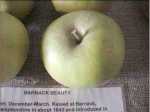
BARNACK ORANGE
- Raised by Mr. W.H. Divers, head gardener at
Belvoir castle, Leics. Deliberate cross : Barnack Beauty x Cox's Orange
Pippin. Similar to Barnack Beaty but sweeter and ripens earlier. Stores
to about Feb. This is a genuuine Leicestershire apple.
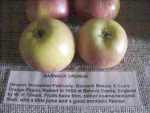
BELVOIR SEEDLING
Apple raised by W.H. Divers, probably at Belvoir Castle, Leicestershire. Received by the National Fruit Trials in 1935. Fruits have firm, fine flesh with a sweet to subacid flavour.
Synonym:
Belvoir Castle. National Fruit Collection Accession Number: 1935-008
Dessert apple, Annie Elizabeth (female) × Dumelow's Seedling (male).
Flowering:
10% open: 9th May,
Fully open: 14th May ,
90% over: 22nd May .
Picking time:
Early October .
Natural storage:
November-March .
http://www.nationalfruitcollection.org.uk/full.php?id=502&&fruit=Apple
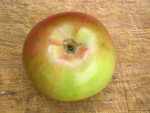
BROWN'S SEEDLING
Usually classed as a Lincolnshire apple. Fruit, two inches and three-quarters wide, and two and a
quarter high ; roundish oblate, very much of the shape of Golden Reinette,
even and regular in its outline, except in the basin of the eye, where it is
slightly ribbed. Skin, lemon yellow where shaded, but almost entirely
covered with light crimson over three-fourths of the surface, and this again
is covered with broken streaks and blotches of deeper and brighter crimson.
Flesh
yellowish white, fine grained, tender, very juicy, having a pleasant
acidity, without much flavour or aroma. A very handsome apple, excellent for culinary purposes, but of
little use in the dessert except for appearance. In use during winter. It
was raised by Messrs. Brown, nurserymen, of Stamford, from whom I received
it in 1874. (Hogg; thanks M.W.)
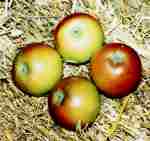
CROFT LATE SEEDLING#
Found near Croft Quarry, Leics; dessert apple resembling Annie Elizabeth and Crawley Beauty but ripens
very much later and is smaller and harder (see Vitamin C page). Firm on the tree
until late December. Scented; keeps fresh, crunchy texture until
March; skin becomes greasy and yellowish when ripe.
Pictures (click on small images for detail):
 ....
....
 ......
......
CROFT SHARP#
Found on outskirts of Croft, Leics; bittersharp cider apple
closely resembling FAIR MAID OF TAUNTON; inedible, high tannin but on
its own makes good cider; scented. Ripe late Sept to early Oct; keeps
until about end-Dec though later in some years. See picture.

CROSS'S PIPPIN#
Apple originating in Hugglescote, around 1930s. Small round eating apple , pale yellow-green skin , does not
keep. No known trees at time of writing.
DUMELOW'S SEEDLING
An apple raised at
Shackerstone, near Ashby, by
the farmer Richard Dumeller in the late 1700s. Probably from
Norfolk Greening pip. Also known as Normanton Wonder. A large,
fairly flat conical apple, pale green and smooth skinned, with
a peculiar scent (which one notices
if an apple is kept in a plastic bag for an hour or two). A good
apple for baking; not really suitable as dessert apple because
of its acidity, which it retains until the spring - can keep until
April. An important Victorian culinary apple, and one of the
main Victorian varieties in gardens and commercially. There
are still many trees remaining in the West Midlands but it's long
since been overtaken by Bramley.

FRENCH CODLIN
Extract from Hogg - " It is common in the districts round Derby, where it is
grown under the name of Leicester -Burton Pippin". Below medium size, smooth skin, pale straw colour. Flesh white, tender, juicy, brisk, without much flavour. An early cooker, of pretty appearance, ripe mid-August. (thanks M.W.)
...update.......we think a tree has been located.....
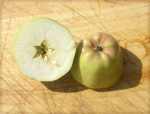
LANGTON NONSUCH#
Apple probably originating in Church Langton, Leics. Believed lost variety. Click on the heading for more details.
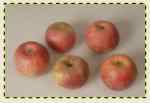
Update - a tree has been located. To our surprise, not in England! It is being re-introduced by Leicestershire Heritage Apples Project.
LORD BURGHLEY
Seedling found in the grounds of
Burghley Park, near Stamford. First fruited 1834. Rescued from waste
ground by head gardener, Mr. Matheson. RHS 1865; introduced by
nurseryman House of Peterborough. Dark red flushed apple, brisk, aromatic,
sweet, juicy, firm flesh. Keeps late (up to Apr or sometimes later).
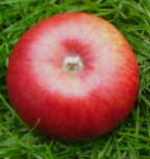
MARRIAGE MAKER
Keepers Nursery describe this apple as a Leicestershire apple. Hogg confirms Marriage Maker as sent to him from Leicester by Harrisons. (thanks M.W.)
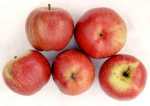
MARTIN'S CUSTARD #
- an old apple which was thought to be extinct. Specimen found by Sally
Cunningham in Cotesbach, Leicestershire, who has kindly allowed me
to photograph a few apples and who has supplied the following comments:
......'The tree is in the oldest part of the orchard at (location witheld)
and probably
dates from around 1850. Tree is big (about 60ft), vigorous and
for its
age quite healthy, with lots of new growth suitable for grafting....I
was asked to give a possible ID as they thought it might be Mere de
Menage, but on reading Hogg's Fruit Manual - his description - Martin's
Custard seems a better fit.
"Fruit medium sized, two inches and three quarters wide and two and a
half high: roundish, ribbed on the sides, and with ridges round the
crown which extend into the basin of the eye. Skin greenish yellow,
mottled with red on the shaded side, and considerably streaked with dark
crimson and with a violet bloom on the side next the sun. Eye, small,
quite closed, set in a narrow puckered basin. Stalk, very short,
sometimes a mere fleshy knob, and sometimes woody with a fleshy swelling
on one side. Flesh, yellowish, firm, crisp, juicy and briskly acid.
An excellent culinary apple: in use from October to Christmas.
This apple is much grown in the orchards conterminous with
Northamptonshire and Leicestershire, and I am indebted for a knowledge
of it to my good friend the Rev M J Berkley, of Sibbertoft, near Market
Harborough."
The only thing I'd quarrel with is the size - it's a bit
bigger, but
this has been a damp season so it's probably within tolerance'.
..........Thumbnail pictures below; click on them for a better view.
Thanks Sally......ND.
Blossom

Fruit from the original tree


Fruit from a newly grafted tree on MM106:

- there are more pictures of this variety on the main apple pictures page.
PEASGOOD NONSUCH
Once very popular in Leicestershire, but it originated outside the county. An enormous, attractive apple of
moderate flavour. Raised by Mrs. Peasgood, 1850s, Grantham; later
taken by her to Stamford when she moved. Exhibited by Mrs. P. later.
Good for cooking; goes to puree. Ok fresh. Good decorative appeal
in the garden - the apples are very striking; green turning to orange red
flush then becoming yellow; some patches of russet. Stores up to Dec
but is well past its best by then. Pick Sept.
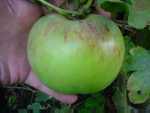 ....
....
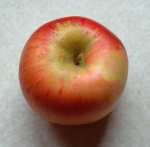 ....
....
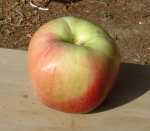 ....
....
PRINCE CHARLES
Dessert, September-October. Lord Lambourne x
Cox's Orange Pippin. Raised between 1940 and 1945 at Victoria Nurseries,
Burbage, Leicestershire, by Herbert Robinson. Fruits have creamy white
flesh with a sweet, slightly subacid, slightly aromatic flavour. (seen
at Brogdale apple exhibition, Oct 2004)
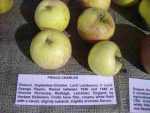
QUEEN CAROLINE
(syn. Spencer's Favourite) - raised and
distributed by Mr. T. Brown, nurseryman of Ashby-de-la-Zouch. He had land
in Measham where his seedlings were raised, c. 1820. Large apple, cooker,
brisk, well flavoured. Named after Geo. IV's wife. Keeps till Xmas.
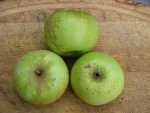
St. AILRED
from Mount St. Bernard Abbey, Coalville, c.1942.
James Grieve x Ellison's Orange. Tastes a bit like James Grieve, resembles Ellison's
Orange. Quite sweet, juicy, soft; cream flesh but taste can be a bit
medicinal. Skin tougher than James Grieve. Pick and eat in Sept; doesn't really
keep.
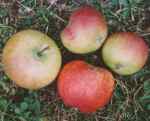
Br. John-Paul Sanderson of Mt. St. Bernard Abbey adds the following:
....Just to add a little to your information on the St. Ailred apple: the monk
who developed the variety was Fr. Ailred McPike, and
he named it after St. Ailred, his patron saint,
and the 12th century Abbot of Rievaulx Abbey in
Yorkshire. For a long time we didn't have a St.
Ailred tree in our orchard, that is until a couple
of years ago when a group of apple enthusiasts,
who look after a village community orchard, came on
a trip to see our orchards, and brought us a St.
Ailred tree as a gift.
St. CECILIA#
Another apple from Mount St. Bernard Abbey. Parentage same as St. Ailred.
St Cecilia season was similar to that of Cox, it was like Lord Lambourne and of medium size.
No known trees at time of writing.
SWEETINGS#
This variety has been found near Queniborough. It was propagated in the 1990s by
Brooksby College, and by Leicestershire Heritage Apples Project in 2010.
WYGGESTON PIPPIN#
Found in mid 90s in grounds of Wyggeston College,
Leicester (ex-Wyggeston Boys); dual purpose, sweet
in good years. Ripe late July; round-conical but slightly
pointed at eye; sour and metallic in poor years (similar
to Allington). Useful for adding to cider.
Pictures (click on small images for detail):
Blossom

Fruit

WYKEN PIPPIN
This is a Warwickshire apple - not far from the Leicestershire border; a small, flat conical yellow-green
fruit, raised in the early 1700s. Lord Craven brought the seeds of the apple back
from a trip to Europe and planted them in the Wyken area of Coventry.
There's a nearby pub called the Wyken Pippin. The apple is densely flavoured fruit with (for a yellow apple)
a surprisingly crisp texture.
Wyken Pippin
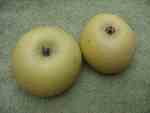
The flavour is rather rich and
aromatic. I pick mine in October and they store in good condition
for about six weeks, though they are best straight off the tree.
More information about this apple is on
http://www.wyken.com/html/the_apple.html
- Many thanks to Sally Cunningham and Melanie Wilson, who supplied the majority of the information above, and to Sue Hancock who corrected my "Wyken Pippin" entry.
Compiled by Nigel Deacon, Diversity website. Thanks to Derek Tolman for supplying three of the pictures and to Mel Wilson for apple information.
....please email us if you know of other Leicestershire apples
# denotes not in National Fruit Collection